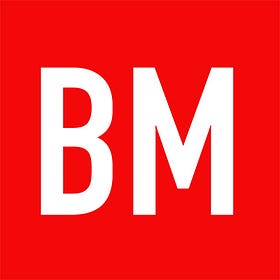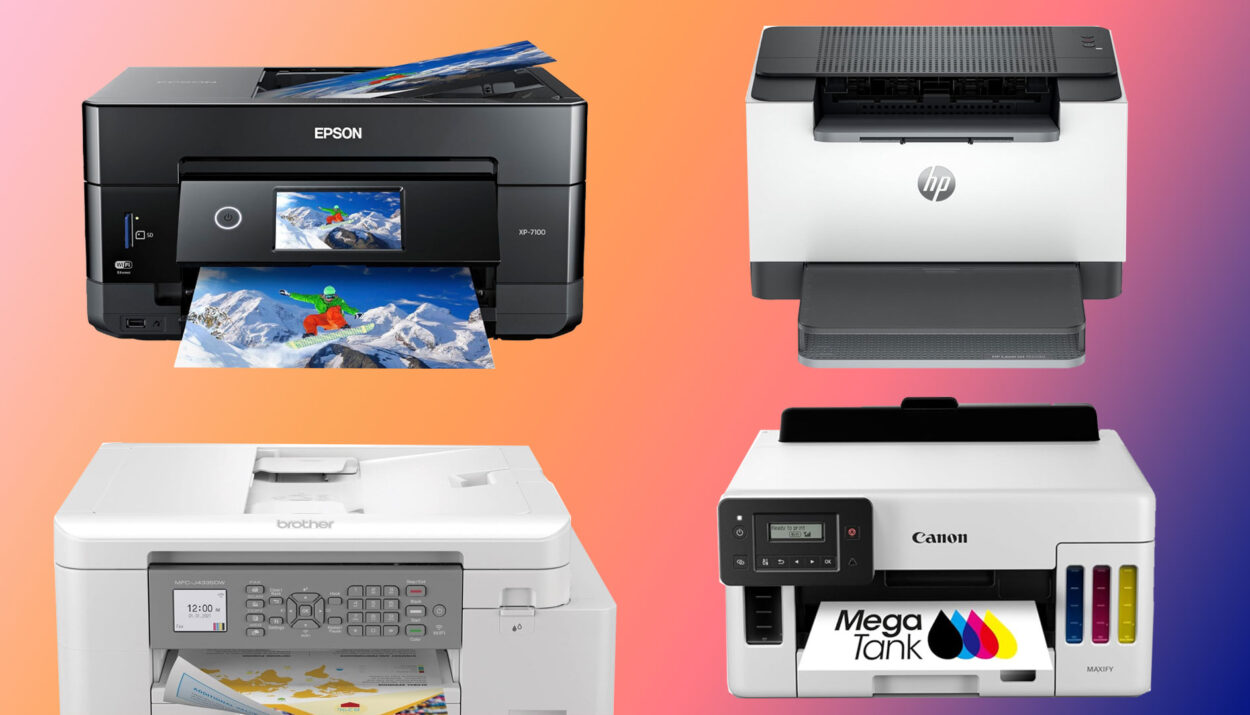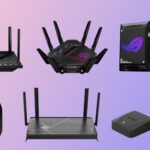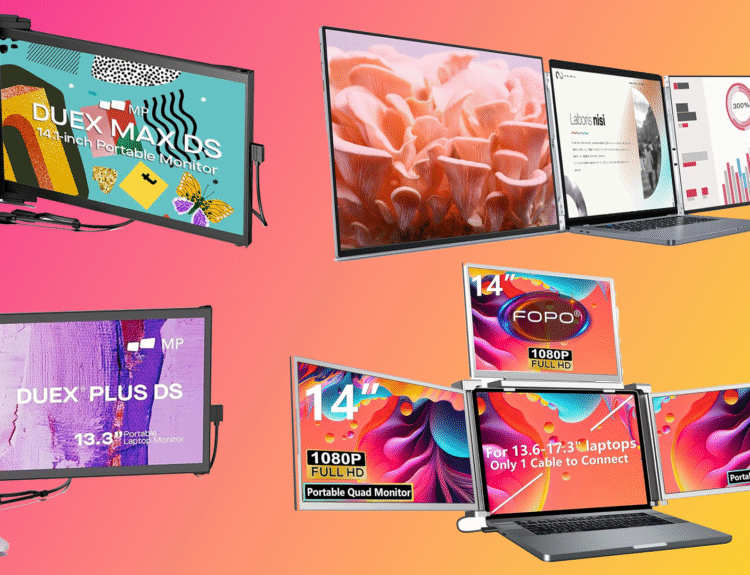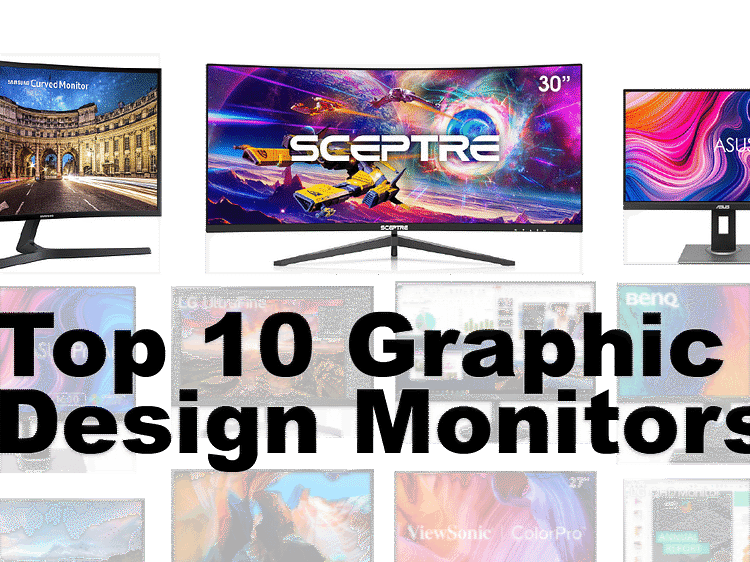While the world is increasingly digital, printers remain essential for homes, offices, and creative work. In 2025, printers are more versatile and efficient, handling everything from documents and photos to specialized media and 3D objects. This guide explores the best printers for 2025, latest printer technology, market trends, and key features, including the impact of AI, digital printing advancements, and sustainability, to help you choose the best device for your needs.
Table of Contents
Key Trends Shaping the Printer Market in 2025
The printer market is undergoing significant transformation, driven by technological advancements, changing user behaviors, and a growing emphasis on efficiency and sustainability. Understanding these trends is crucial for making an informed purchasing decision.
1. Growth of Digital Printing and Automation
The biggest trend in the printer industry has been the growth of digital printing. This technology allows for greater flexibility, faster turnaround times, and cost-effective production of short runs and personalized items. The future of printing technology is expected to involve a significant focus on automating the entire printing process, with features like automatic document feeders and automatic duplexing becoming increasingly common. The global digital printing market is expected to reach $34.3 billion by 2025.
2. AI-Powered Printers and Workflow Automation
Artificial intelligence is making its way into printer technology, enabling devices to learn user preferences, predict printing requirements, and automatically adjust settings for optimal results. AI-driven apps and capabilities are streamlining workflows, allowing users to access cloud-based storage and even edit documents directly from their printers. This integration of AI promises to make printing more intuitive and efficient.
3. Sustainability and Eco-Friendly Solutions
With a growing global emphasis on environmental responsibility, the printer industry is responding with more sustainable practices. This includes the development of energy-efficient printers, the use of recycled materials in manufacturing, and the availability of affordable and environmentally friendly ink and toner options. Companies are investing in technologies that reduce waste and promote a greener printing ecosystem.
4. Increased Demand for Home Printing and Mobile Connectivity
The rise of remote work and home-based learning has led to a substantial increase in demand for home printers. Users require devices that are easy to set up, reliable, and capable of handling a variety of tasks. Mobile printing, cloud-based computing, and software integration are also driving growth, allowing users to print directly from their smartphones, tablets, and cloud storage services.
5. Market Size and Growth Projections
The Printer Market size is estimated at USD 56.82 billion in 2025, and is expected to reach USD 70.98 billion by 2030, at a Compound Annual Growth Rate (CAGR) of 4.55% during the forecast period (2025-2030). This growth is driven by technological progress, rising demand across various industries, and strategic moves by major companies. Asia-Pacific is projected to be the fastest-growing market, while North America remains the largest market.
What to Look For in a Printer in 2025
Choosing the right printer in 2025 involves balancing your specific needs with the array of features and technologies available. Here’s a guide to the key considerations:
1. Inkjet vs. Laser: Understanding the Core Difference
- Inkjet Printers: Ideal for home users and those who need to print photos, inkjet printers use liquid ink to produce images by spraying tiny droplets onto paper. They excel at producing vibrant colors and detailed graphics. Modern inkjets are becoming more efficient, with some models featuring refillable ink tanks that significantly reduce per-page costs and environmental impact. Inkjet printing is projected to maintain a substantial market share due to its efficiency in producing short-runs and personalized items.
- Laser Printers: Best suited for high-volume text printing in office environments, laser printers use toner powder and a laser to fuse the image onto paper. They are known for their speed, sharp text quality, and lower cost per page for monochrome documents. Color laser printers are also available, offering fast and high-quality color output for business documents.
2. All-in-One (Multifunction) vs. Single-Function: Versatility Matters
- All-in-One (AIO) Printers: These devices combine printing, scanning, copying, and often faxing capabilities into a single unit. They are excellent space-savers and cost-effective for home offices or small businesses that need multiple functionalities. Many AIOs also offer advanced features like automatic document feeders (ADF) for scanning multi-page documents and duplex printing.
- Single-Function Printers: If your primary need is just printing, a dedicated single-function printer can be a more economical choice, often offering faster print speeds and higher print quality for its specific task.
3. Connectivity Options: Wireless is Key
In 2025, wireless connectivity is almost a given. Look for printers with Wi-Fi for easy integration into your home or office network, allowing you to print from computers, smartphones, and tablets without physical cables. Features like Wi-Fi Direct, Apple AirPrint, and Mopria Print Service enable direct printing from mobile devices without needing a router. Ethernet ports are still valuable for stable, high-speed wired connections, especially in office settings.
4. Print Speed and Quality: Balancing Needs
Print speed, measured in pages per minute (ppm), is crucial for high-volume users. However, don’t sacrifice quality for speed. For text documents, look for sharp, crisp output. For photos, assess color accuracy, detail, and resistance to fading. Many printers offer different print quality settings, allowing you to optimize for speed or quality depending on the task.
5. Cost of Consumables: Ink and Toner Economy
The initial purchase price of a printer is often just the beginning. The ongoing cost of ink cartridges or toner can quickly add up. Research the cost per page for replacement consumables. Printers with high-yield cartridges or refillable ink tanks (like Epson EcoTank or Canon MegaTank) offer significantly lower running costs over time, making them more economical in the long run.
6. Duplex Printing: Saving Paper and Money
Automatic duplex printing (two-sided printing) is a valuable feature that saves paper and reduces environmental impact. It’s a standard feature on many modern printers and can be a significant cost-saver for frequent printing.
7. Paper Handling: Capacity and Media Types
Consider the paper capacity of the input tray, especially if you print large documents frequently. Also, check what types of media the printer can handle, such as photo paper, cardstock, envelopes, or labels. Some printers also offer specialized trays for different paper sizes or types.
8. Smart Features and Cloud Integration: Enhanced Convenience
Many 2025 printers come with smart features like touchscreens, cloud printing capabilities (e.g., Google Cloud Print, Mopria), and integration with voice assistants. These features enhance convenience, allowing you to print from virtually anywhere and manage your printer remotely. AI-powered apps are also becoming more prevalent, offering streamlined workflows [3].
9. Security: Protecting Your Data
For business environments, printer security is increasingly important. Look for features like secure boot, firmware validation, and user authentication to protect sensitive data and prevent unauthorized access to the printer or network.
Top Printers for 2025: Our Top Picks
Based on extensive testing and evaluation, here are some of the best printers available in 2025, catering to various needs and budgets. These selections prioritize print quality, speed, features, and overall value.
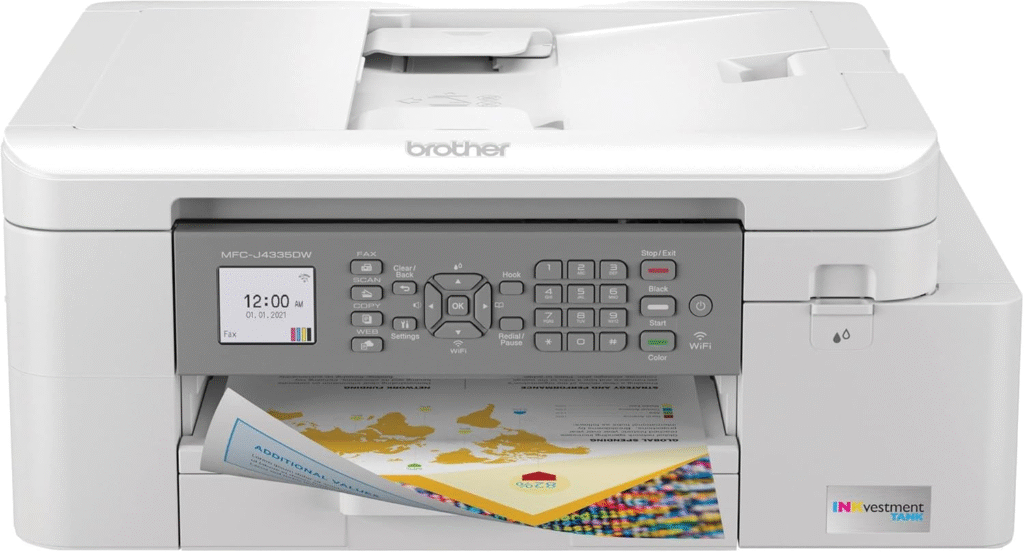
1. Brother MFC-J4335DW
Why we recommend it: This all-in-one inkjet printer is an excellent choice for most home users, offering a balance of affordability, functionality, and low running costs. It provides fast print speeds for its price, duplex printing, and mobile device support, making it a versatile solution for everyday printing, scanning, copying, and even faxing needs.
Pros:
- Duplex printing (two-sided)
- Fast print speed for the price
- Fax function included
- Prints from and scans to mobile devices
- Low initial price and low cost per page
Cons:
- ADF (Automatic Document Feeder) does not support duplex scanning
- Text quality can be poor at small font sizes and with some stylized fonts
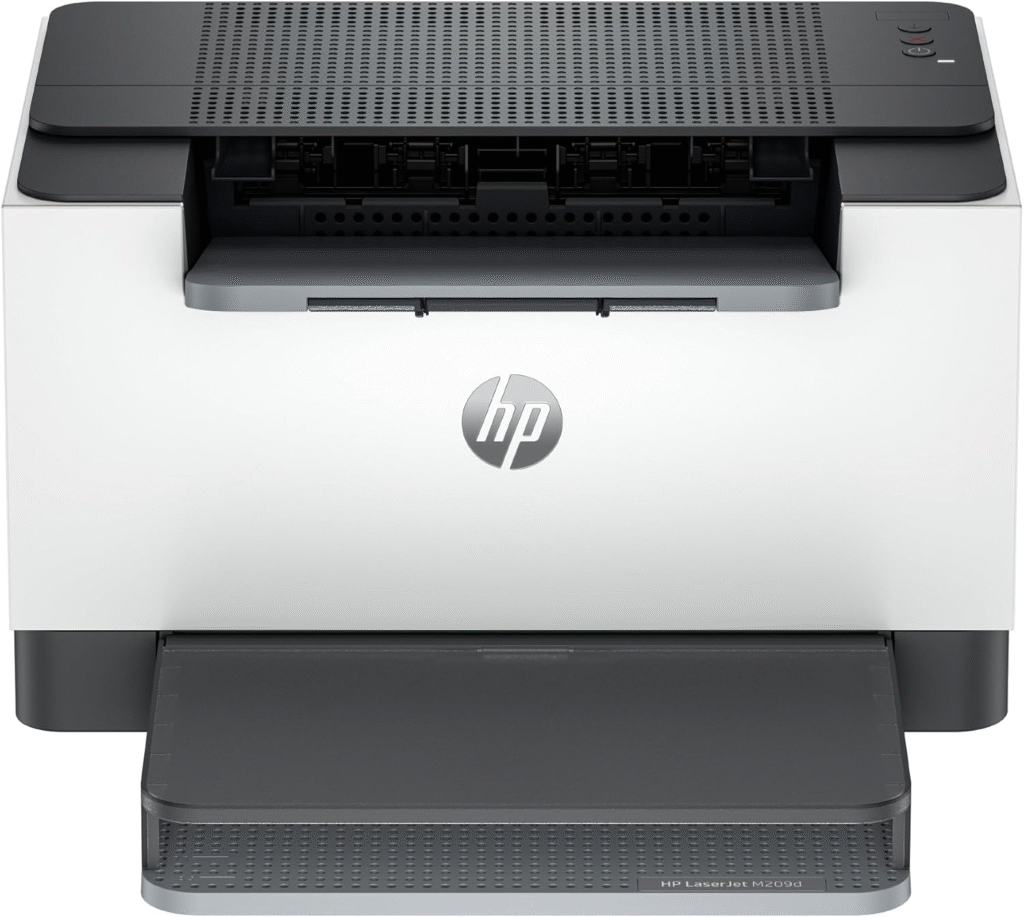
2. HP LaserJet M209d
Why we recommend it: For users primarily focused on monochrome text printing, the HP LaserJet M209d is a solid choice. It offers better print quality than many lasers in its price range, with crisp, sharp text. Its front-loading tray and automatic duplex printing make it convenient for handling everyday document printing tasks.
Pros:
- Better print quality than most lasers in its price range
- Front-loading tray for easy refills and paper-type changes
- 150-sheet capacity
- Automatic duplex (two-sided) printing
Cons:
- No bypass paper feed or optional additional trays
- No Wi-Fi or Ethernet connectivity
- Does not support mobile printing
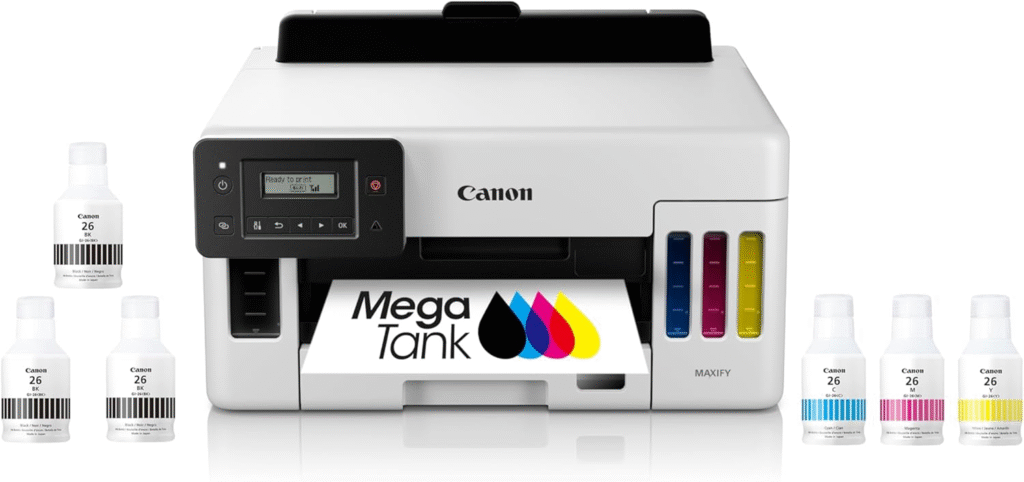
3. Canon Maxify GX5020
Why we recommend it: The Canon Maxify GX5020 is an excellent ink tank printer for homes and small offices, offering incredibly low ink costs over time. Its refillable ink tanks eliminate the need for expensive cartridges, making it a cost-effective solution for high-volume printing. It also boasts versatile connectivity options, including Ethernet, USB, and Wi-Fi, along with duplex printing and mobile device support.
Pros:
- Very low ink cost due to ink tank system
- Ethernet, USB, and Wi-Fi connections for versatile connectivity
- Duplex printing
- Mobile device support
Cons:
- Higher initial purchase price compared to cartridge-based printers
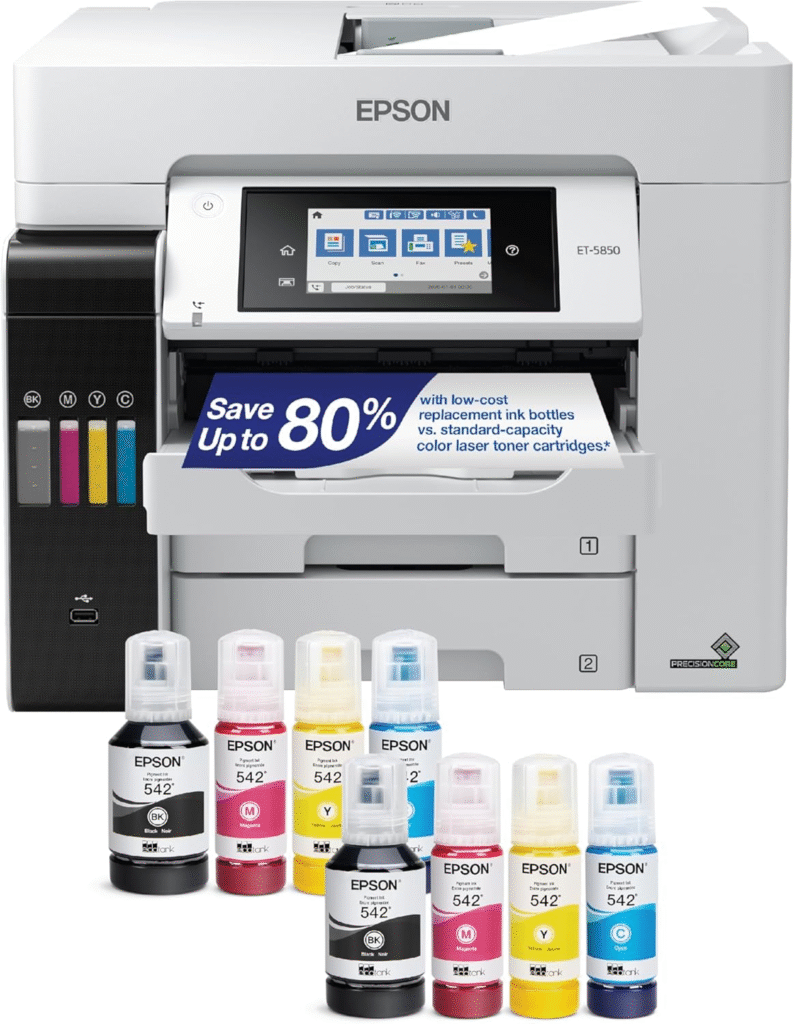
4. Epson EcoTank Pro ET-5850
Why we recommend it: For businesses with high printing demands, the Epson EcoTank Pro ET-5850 is a standout. It offers two years of unlimited ink (with registration), resulting in very low running costs and terrific print quality. Its auto-duplexing ADF, PrecisionCore 4S printhead, and excellent mobile connectivity options make it a highly efficient and reliable workhorse for busy office environments.
Pros:
- Two years of unlimited ink (with registration) and very low running costs
- Terrific print quality
- Auto-duplexing ADF for efficient scanning
- PrecisionCore 4S printhead for high performance
- Excellent mobile connectivity options
- Two-year warranty with registration
Cons:
- High initial purchase price

5. Brother MFC-L3780CDW
Why we recommend it: This color laser all-in-one printer is a robust solution for small to medium-sized businesses. It prints, scans, copies, and faxes, offering relatively fast speeds and competitive toner costs. Its excellent print, copy, and scan quality, along with a 50-page single-pass auto-duplexing ADF, make it a highly efficient and versatile device for a demanding office environment.
Pros:
- Prints, scans, copies, and faxes
- Relatively fast print speeds
- Competitive toner costs
- Excellent print, copy, and scan quality
- 50-page single-pass auto-duplexing ADF
- Wide range of wireless connection options, including NFC
Cons:
- Modest 30-sheet multipurpose tray
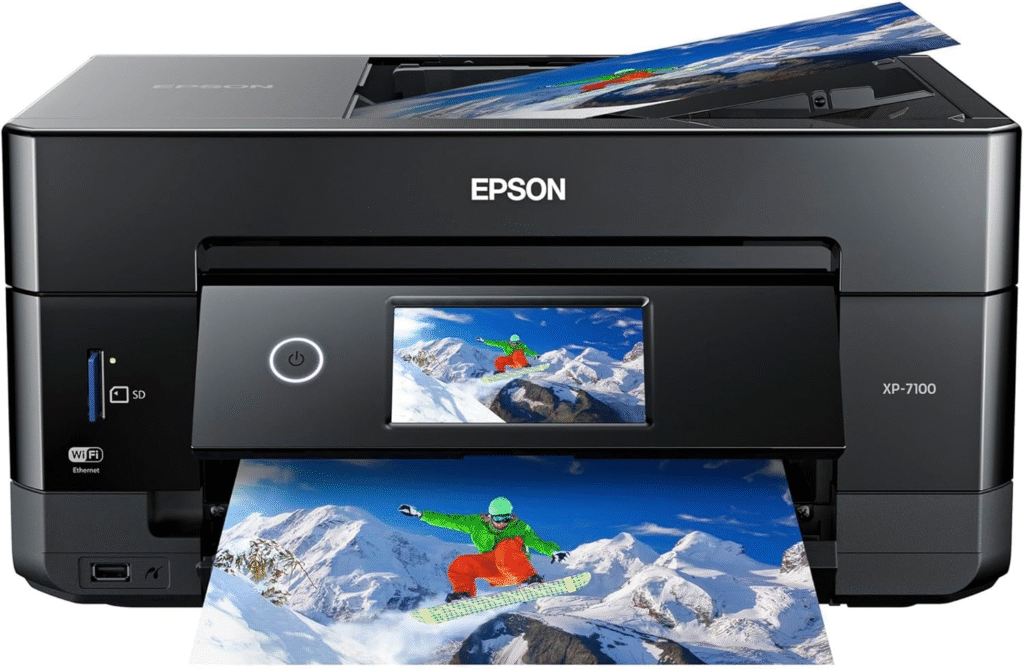
6. Epson Expression Premium XP-7100 Small-in-One Printer
Why we recommend it: For those who prioritize photo printing, the Epson Expression Premium XP-7100 delivers exceptional output quality. While it has higher running costs and lower paper capacity than some other models, its ability to produce vibrant and detailed photos makes it a great choice for photographers and creative users. It also includes a single-pass duplexing ADF and a large, easy-to-use control panel.
Pros:
- Exceptional output quality, especially for photos
- Single-pass duplexing ADF
- Large, easy-to-use control panel
- Robust connectivity options
Cons:
- High running costs for ink
- Low paper capacity
Top FAQs on The Best Printers for 2025
The printing landscape in 2025 is characterized by greater versatility, efficiency, and intelligence. Here, we address some common questions to guide your printer purchase.
1. What are the key trends shaping the printer market in 2025?
Several significant trends are influencing the printer market in 2025:
- Sustainability as a Core Imperative: There’s a strong push towards eco-friendly practices, including the use of recycled materials, biodegradable and plant-based inks (soy, vegetable, algae), waterless printing, energy-efficient designs, and closed-loop recycling programs for consumables.
- AI Integration: Artificial intelligence is playing an increasingly vital role, from predictive maintenance and automated supply reordering to optimizing print quality, color calibration, and even helping to generate designs.
- Cloud-Based Printing & IoT: Seamless integration with cloud services and IoT (Internet of Things) allows for printing from anywhere, remote monitoring, and automated diagnostics, enhancing convenience and efficiency.
- Increased Versatility and Specialization: Printers are becoming more specialized, catering to niche needs like direct-to-film (DTF) printing for crafting businesses, sublimation for custom merchandise, and advanced 3D printing applications beyond hobbyist use.
- Print-on-Demand and Personalization: The demand for on-demand printing and highly personalized materials continues to grow, driven by digital printing’s flexibility and efficiency for shorter runs.
- Hybrid Work Optimization: Printers are designed to support hybrid work environments, offering robust wireless connectivity, enhanced security features, and user-friendly interfaces for both home and office use.
2. What kind of printer should I buy in 2025 for home use?
For most home users in 2025, an all-in-one inkjet printer with refillable ink tanks (like Epson EcoTank or Canon MegaTank) offers the best balance of features, low running costs, and versatility. These are excellent for documents and photos, and their tank systems significantly reduce the cost per page compared to traditional cartridges.
- For heavy document printing: A monochrome laser printer is ideal for fast, crisp text and very low cost per page.
- For photo enthusiasts: Dedicated photo printers or high-end inkjets with multiple ink colors will provide superior photo quality.
- For small spaces or occasional printing: A compact all-in-one inkjet might suffice, but be mindful of ink costs.
3. What is the role of AI in printing technology in 2025?
AI is fundamentally transforming printing in 2025 by making devices smarter, more efficient, and more reliable:
- Predictive Maintenance: AI analyzes sensor data to predict potential malfunctions and schedule maintenance proactively, minimizing downtime and extending printer lifespan.
- Automated Optimization: AI algorithms can optimize ink usage, print job layouts (e.g., smart ganging), color consistency, and image resolution, leading to better print quality and reduced waste.
- Enhanced Security: AI is being used to detect and mitigate sophisticated cyber threats targeting networked printers, enhancing overall print infrastructure security.
- Intelligent Document Processing (IDP): AI can streamline workflows by automating tasks like data extraction from scanned documents and integrating with cloud-based document management systems.
- Personalization and Design: AI-powered tools can assist in generating customized content, optimizing designs, and even predicting consumer preferences for tailored print products.
4. What are the best printers for a small office in 2025?
For small offices, multifunction laser printers (MFPs) are often the best choice due to their speed, durability, and low cost per page for high-volume document printing.
- Color Laser MFPs: Offer excellent quality for documents with color graphics and can handle larger print jobs efficiently.
- Monochrome Laser MFPs: Ideal if most of your printing is black and white, providing very fast and economical output.
- Ink Tank All-in-Ones (Business Grade): For offices with moderate to high print volumes that also require good color and photo capabilities, business-focused ink tank models can offer competitive running costs and versatility.
Look for features like automatic document feeders (ADF), duplex printing (two-sided), robust network connectivity (Wi-Fi, Ethernet), and strong security.
5. What are the latest advancements in ink and toner technologies?
In 2025, ink and toner advancements focus on sustainability, efficiency, and quality:
- Eco-friendly Inks: A significant shift towards water-based, soy-based, vegetable-based, and even algae-based inks, which are renewable, produce fewer VOCs (volatile organic compounds), and are more biodegradable.
- UV-LED Curing: This technology uses LED lights to instantly cure inks, significantly reducing energy consumption and the need for traditional heat-based drying.
- Higher Yield and Less Waste: Improved ink formulations and tank systems mean cartridges last longer, reducing the frequency of replacements and overall waste.
- Enhanced Color Accuracy and Durability: New formulations provide more vibrant colors, greater permanence, and better resistance to fading and smudging.
- Remanufactured and Refillable Cartridges: The market for remanufactured and easily refillable cartridges is growing, contributing to the circular economy and reducing plastic waste.
6. Is 3D printing becoming more accessible for home users in 2025?
Yes, 3D printing continues to expand beyond industrial applications and is becoming more accessible for prosumers and serious hobbyists in 2025. While dedicated 3D printers are still a specialized category, advancements in user-friendliness, software, and filament options are making them easier to operate. We’re seeing more reliable desktop models and a wider community for sharing designs and troubleshooting. For general home users, integrated 3D printing capabilities in standard “all-in-one” home printers are not yet common, but dedicated 3D printers are more affordable and capable than ever.
7. What is “eco-friendly printing” in 2025?
Eco-friendly printing in 2025 encompasses a holistic approach to minimizing environmental impact throughout the printing lifecycle:
- Sustainable Materials: Using recycled paper (with high post-consumer content), responsibly sourced certified papers (FSC, PEFC), and alternative fibers like hemp and bamboo.
- Green Inks: Employing water-based, soy-based, and biodegradable inks that are less harmful to the environment and workers.
- Energy Efficiency: Printers designed with Energy Star certification, sleep modes, faster warm-up times, and power-saving features like UV-LED curing.
- Waste Reduction: Implementing print-on-demand models, automated ink optimization, duplex printing, and robust recycling programs for cartridges and old equipment.
- Closed-Loop Systems: Technologies that allow for the recapture and reuse of chemicals and materials in the printing process.
- Sustainable Packaging: Using recyclable or compostable packaging for printer supplies and reducing unnecessary packaging layers.
8. What are the advantages of cloud printing platforms?
Cloud printing platforms are a significant trend in 2025, offering several advantages:
- Print from Anywhere: Users can send print jobs from any device (laptop, tablet, smartphone) with an internet connection, without needing specific drivers or direct network connections.
- Simplified Management: IT departments can centralize printer management, monitor usage, and deploy updates remotely, reducing administrative burden.
- Enhanced Security: Cloud platforms often incorporate robust security features, including encryption and user authentication, protecting sensitive documents.
- Cost Efficiency: Reduces the need for on-premise print servers and associated maintenance costs.
- Scalability: Easily scales to accommodate growing business needs without significant hardware investments.
9. How important is connectivity (Wi-Fi, Ethernet) in 2025 printers?
Connectivity is more crucial than ever in 2025. Nearly all modern printers, especially those for home and small office use, offer robust wireless (Wi-Fi) connectivity as a standard. This enables printing from various devices, including smartphones and tablets, without physical cables. Ethernet ports remain important for stable, high-volume printing in office environments. Bluetooth and NFC (Near Field Communication) are also becoming more common for quick pairing and tap-to-print functionality.
10. Should I choose an inkjet or a laser printer in 2025?
The choice between inkjet and laser depends on your primary printing needs in 2025:
- Inkjet Printers:
- Pros: Better for color photos and graphics, lower initial purchase cost, often more compact, and refillable ink tank models offer very low running costs. Can print on a wider variety of media types.
- Cons: Slower for high-volume text documents, ink cartridges can dry out if not used regularly (less of an issue with tank systems), potential for clogging.
- Best for: Homes, creative professionals, those who print a mix of documents and photos, and users looking for vibrant color output.
- Laser Printers:
- Pros: Faster for black-and-white text, lower cost per page for high volumes, toner doesn’t dry out, excellent for sharp text documents, generally more durable.
- Cons: Higher initial purchase cost (especially for color laser), less adept at printing high-quality photos, larger footprint.
- Best for: Offices, heavy document printing, users needing fast and consistent text output, and those who prioritize low running costs for monochrome prints.
Many modern inkjet printers with tank systems are bridging the gap in running costs, making the decision more about print quality preference and initial investment.
